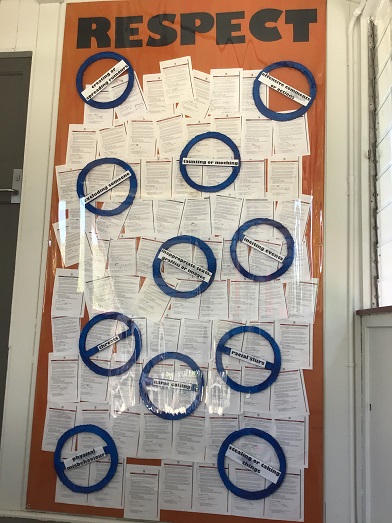Esk State School is committed to providing a safe, respectful and disciplined learning environment where students have opportunities to engage in quality learning experiences and acquire values supportive of their lifelong wellbeing. Our school fosters a warm, supportive environment where students can be happy and where optimal learning can take place. This means that we facilitate positive behaviour, discourage problem behaviour and respond to unacceptable behaviour.
Every child has the right to feel safe, to be respected and learn in a positive environment. Yet, this doesn't always happen. Bullying, harassment, and discrimination are all interpersonal behaviours that can create or contribute to a negative social environment. Esk State School has a clear definition outlined in the Student Code of Conduct in regards to bullying and states the anti-bullying procedures that are practiced as part of our school-wide positive behaviour support processes. The Student Code of Conduct outlines the school approach to responding to bullying, and also contains the Antibullying Compactum that is reviewed annually and signed upon enrolment.
Bullying can be verbal (name calling or insulting someone about their physical characteristics, beliefs or personal opinions), physical (hitting or hurting someone, intimidating another or damaging their belongings) and social (excluding another person or sharing information that will have a harmful effect on them).
However, anti-social behaviour alone doesn't define bullying. If any of these behaviours occur only once, or are part of a conflict between equals, they are not bullying. Though undesirable, teasing, arguments and one-off acts of aggression and meanness are a normal part of life for young people. Bullying, however, is ongoing and the deliberate misuse of power in relationships through the repeated verbal, physical and/or social behaviour that intends to cause physical, social and/or psychological harm. The exception to this is cyber bullying, due to the virulent nature of a single post, and agressive group orientated behaviours - eg. ganging up.
It can be distressing to learn that our child is being teased or has had an argument with another child at school. However, no matter how difficult these occurrences may be, they are a normal part of life, regardless of our age. Learning resilience in these difficult times is crucial whether we are a child or an adult. We all need the fire of testing to build resilience and strength of character.
When children are experiencing unpleasant circumstances with peers at school, there are intentional resilient-building actions parents and carers can employ to help them process their emotions and grow strong and self-assured. These practices include focussing on the positives of our lives, being thankful for what we have, maintaining clear rules and boundaries with consequences, expecting and modelling best practices and developing and deepening personal values so that children have strong commitments that guide how they think and act.
These actions are no less relevant for those times when parents suspect that their child is experiencing bullying. However, in cases of bullying, it is important for the school and the parents to build strong channels of communication to work together to address the bullying.
There is no place for bullying in Esk State School. Those who are bullied and those who bully are at risk of behavioural, emotional or academic problems. All of which are in direct contradiction to our school community's goals and efforts to support all students. For further information on Esk State School's response to bullying see The Responsible Behaviour Plan for Students found at this website or visit Bullying No Way and Resilient Youth Australia for a range of informative resources on building resilience.

